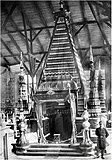General National Exhibition in Lviv
| 1894 Austro-Hungarian Empire | |
|---|---|
| City | Lviv |
| Timeline | |
| Opening | 5 June 1894 |
| Closure | 15 October 1894 |
The General National Exhibition in Lviv (Polish: Powszechna Wystawa Krajowa we Lwowie) was a national exposition held in 1894 in the city of Lviv (Polish: Lwów) on the centenary of the Kościuszko Uprising. Its aim was to showcase the economic and cultural achievements of Galicia and to present the works of art of the Kingdom of Galicia and Lodomeria as well as all other Polish lands under foreign rule.
History

Preparations before the grand opening of the exhibition took around two years. Architects
The ceremonial opening of the exhibition took place on 5 June 1894 after a religious service held at
During the exhibition, a number of conferences were held and an
Among the few preserved buildings from the exhibition is the Palace of Arts (Polish: Pałac sztuki). Situated in Stryj Park, it was designed by Polish architect Franciszek Skowron in the Baroque Revival architectural style. It features an allegorical sculpture representing Art created by Julian Markowski. Figures representing Sculpture and Painting were located on both sides of the entrance to the palace and were executed by Antoni Popiel. The pavilion housed three exhibitions: A Retrospective of Polish Art, The Antiques Exhibition, and The Exhibition of Contemporary Art.[8]
The exhibition also hosted a retrospective of Polish painting from all three partitions, which was organized by professors Marian Sokołowski and Jan Bołoz-Antoniewicz. It featured works by such artists as
Significance
It was the biggest fair in the history of the city and greatly contributed to its further modernization and the initiation of numerous other infrastructure projects.
Main pavilions


Notable pavilions and structures constructed for the exhibition included:
- Main Gate (Brama główna)
- Gródecka Street Gate (Brama u wylotu ulicy Gródeckiej)
- Hutsul Tserkva (Cerkiew huculska)
- The Manor House (Dwór szlachecki)
- The Ethnographic Department (Dział etnograficzny)
- Electric Fountain of Lights (Elektryczna fontanna świetlna)
- The Concert Hall (Hala koncertowa)
- The Machine Hall (Hala maszyn)
- The Palace of Arts (Pałac Sztuki)
- The Architecture Pavilion (Pawilon architektury)
- The Imperial Pavilion (Pawilon cesarski)
- The Count Roman Potocki Pavilion (Pawilon dóbr hr. Romana Potockiego)
- The Jan Matejko Pavilion (Pawilon Jana Matejki)
- The City of Lviv Pavilion (Pawilon miasta Lwowa)
- The Ministry of the Treasury Pavilion (Pawilon Ministerstwa Skarbu)
- The Horticultural Pavilion (Pawilon ogrodnictwa)
- The Racławice Panorama Pavilion (Pawilon Panoramy Racławickiej)
- The Industrial Pavilion (Pawilon przemysłu)
- The Ukrainian Societies Pavilion (Pawilon towarzystw ukraińskich)
- The Water Tower (Wieża wodna)
Gallery
-
Poster of the National Exhibition in Lviv in 1894
-
Baczewski Distillery Pavilion
-
The Architecture Pavilion
-
Water tower
-
Pavilion of the Ministry of Treasury
See also
- History of Poland (1795–1918)
- History of Lviv
- Poznań International Fair
- St. Dominic's Fair
- Targi Wschodnie
- Targi Północne
References
- ^ "STRYISKYI PARK". Retrieved 22 December 2020.
- ^ "The Pavilions of the Galician General Regional Exhibition of 1894". Retrieved 22 December 2020.
- ^ "The Battle of Racławice – Wojciech Kossak, Jan Styka (in cooperation with other painters)". Retrieved 22 December 2020.
- ^ "The General Regional Exhibition of Galicia". Retrieved 22 December 2020.
- ^ "THE GRAND OPENING OF GENERAL REGIONAL EXHIBITION". Retrieved 22 December 2020.
- ^ "5 czerwca 1894 r. Powszechna Wystawa Krajowa we Lwowie". Retrieved 22 December 2020.
- ^ "Five Fun Facts about the Galician General Regional Exhibition of 1894". Retrieved 22 December 2020.
- ^ "The Pavilions of the Galician General Regional Exhibition of 1894". Retrieved 22 December 2020.
- ^ "Five Fun Facts about the Galician General Regional Exhibition of 1894". Retrieved 22 December 2020.
- ^ "Targi Wschodnie". Retrieved 22 December 2020.





